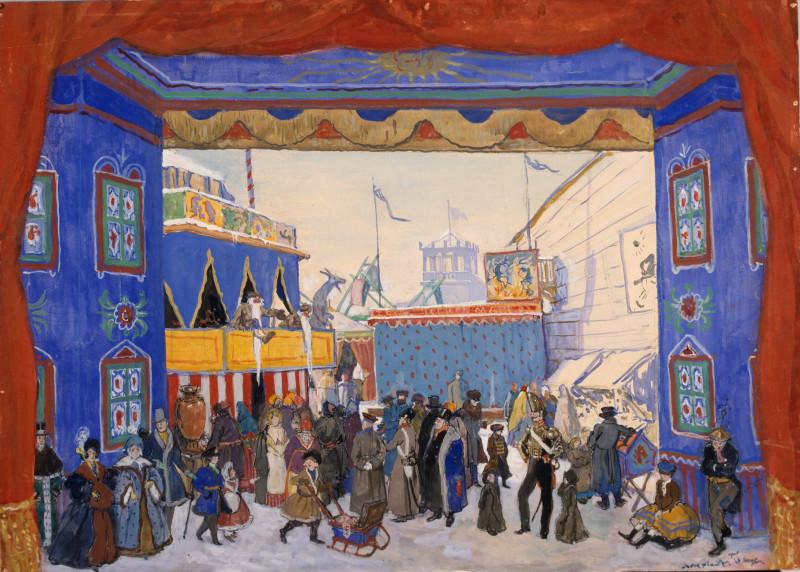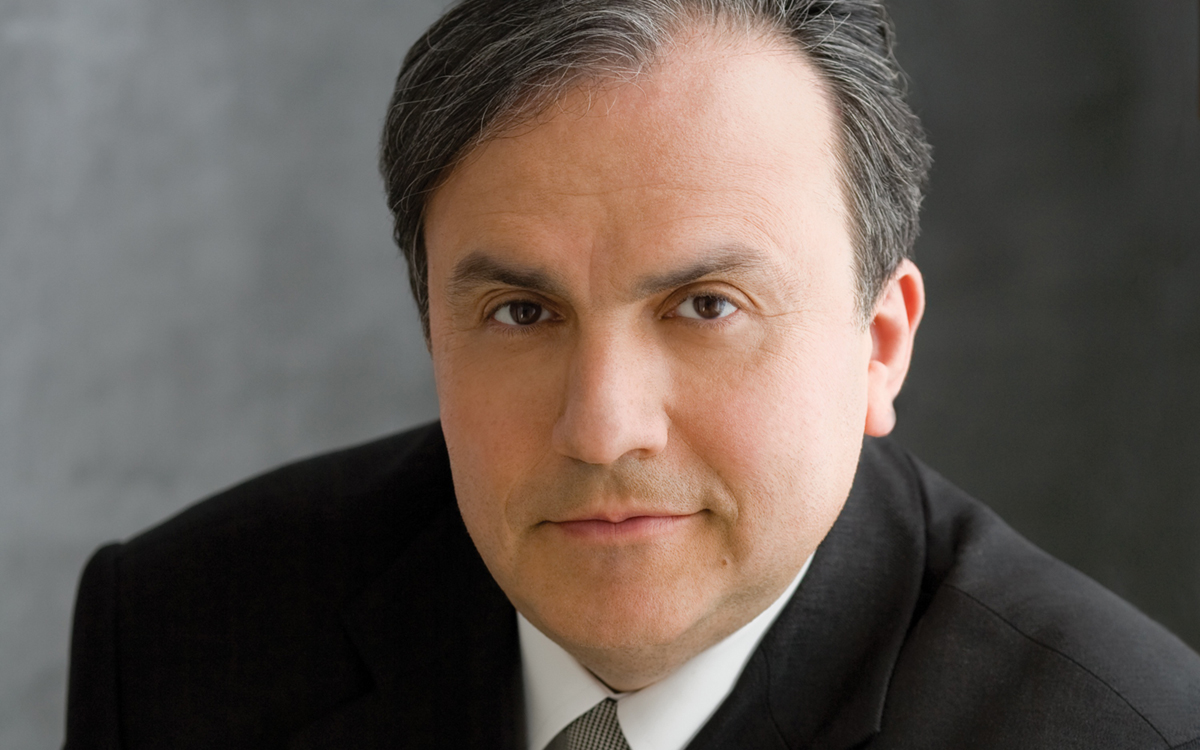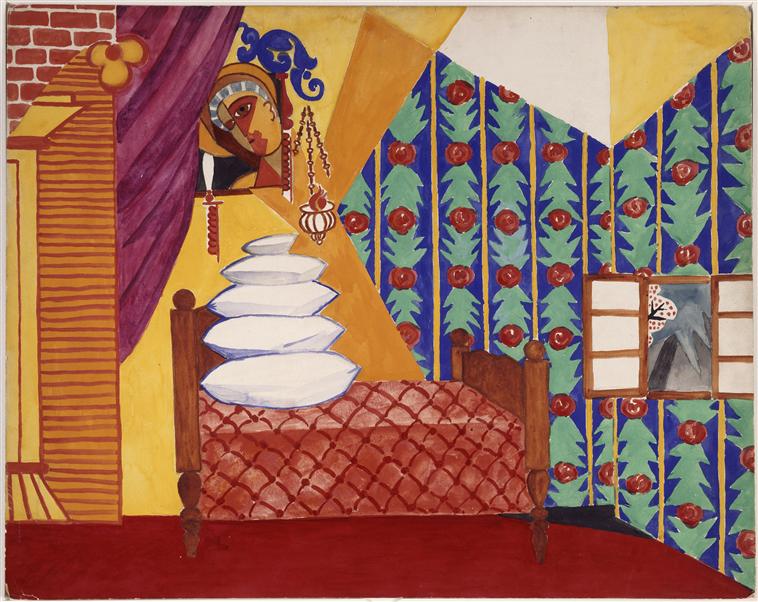Bronfman, LPO, Jurowski, RFH | reviews, news & interviews
Bronfman, LPO, Jurowski, RFH
Bronfman, LPO, Jurowski, RFH
Two playful Ballets Russes scores outdance the UK premiere of an elephantine concerto

Over the past two Saturdays, Vladimir Jurowski and a London Philharmonic on top form have given us a mini-festival of great scores for Diaghilev’s Ballets Russes.
You never know what to expect from the LPO’s Finnish composer-in-residence Magnus Lindberg. He’s often served up knotty, for me rather arid scores of extreme complexity – January’s Accused with Barbara Hannigan seems to have been one such according to theartsdesk’s review – but took me by surprise with a luminously tonal concerto for the astounding clarinettist Kari Kriikku. Pianist Yefim Bronfman (pictured below by Dario Acosta) is in the same league, and brought his Russian-school weight to bear on the Second Piano Concerto composed for him and the New York Philharmonic during Lindberg’s tenure with that hard-hitting band. Yet the more coruscating the performance, the emptier the substance came to seem, especially given the lack of discernible shape on a first hearing.
 Believe me, Prokofiev and Stravinsky would have laughed this baggy monster to scorn. Just because you have a huge orchestra at your fingertips, there’s no need to go for Hollywood film-score overload. There are memorable sounds in the piece, especially when solo strings comment on the pianist’s labours, but no great ideas. If you’re going to imitate Rachmaninov and Ravel, you need melodies to match; instead I was reminded more of the dead weight in concertos by Khachaturian and Shchedrin. Second-drawer music, to be sure, in a first-class performance. What a waste of Bronfman's huge talent, especially since he's one of the few pianists around who can play another Second, Prokofiev's far more engaging monsterpiece.
Believe me, Prokofiev and Stravinsky would have laughed this baggy monster to scorn. Just because you have a huge orchestra at your fingertips, there’s no need to go for Hollywood film-score overload. There are memorable sounds in the piece, especially when solo strings comment on the pianist’s labours, but no great ideas. If you’re going to imitate Rachmaninov and Ravel, you need melodies to match; instead I was reminded more of the dead weight in concertos by Khachaturian and Shchedrin. Second-drawer music, to be sure, in a first-class performance. What a waste of Bronfman's huge talent, especially since he's one of the few pianists around who can play another Second, Prokofiev's far more engaging monsterpiece.
The sparkling sounds either side of Lindberg's elephant in the room could easily have been poking fun at its pretensions. Both Prokofiev in the somersaulting dance-finale of Chout – a piece I’ve always thought would make a superb encore-alternative to the usual "Death of Tybalt" from Romeo and Juliet – and Stravinsky in the Shrovetide fairground bustle that kicks off Petrushka like a massive barrel-organ know how to be light with huge forces – and we got the luxury original, 1911 version of Petrushka rather than the relatively slimline 1947 revision; not that, a few smudges early on apart, Jurowski was going to make this astounding score sound anything other than razor-sharp.
He had a predictably top team of LPO soloists to shine in this concerto for orchestra that also manages to speak, shriek, whimper and charm. Guest principal flautist Michael Cox – he does get around – coaxed the puppets of Petrushka, his beloved Ballerina and the rival Moor (unfortunate racist stereotype) to life. The piano role has remnants of the ballet’s virtuoso concert-piece origins, and having just listened to Jean-Efflam Bavouzet including Petrushka on his Stravinsky concertos CD, I wondered if we’d be back to reticent orchestral pianist. Not a bit of it: Catherine Edwards cut through the textures from centre-left, hit every note spot-on and captured all the facets of the schizoid Pierrot/Mr Punch.
Even xylophonist Sarah Mason among a high-profile percussion array made us hear more of another astonishing part. And if ace cornettist Nicholas Betts tripped momentarily on the Ballerina’s high-wire act, Paul Benniston and Anne McAneny held their nerve as the splitting-off, spitting ghost of Petrushka on the puppet-theatre roof in a perfect abrupt ending. Full marks, incidentally, to the LPO for including supertitles for the ballet action a second week running: you could always ignore them if you just wanted to hear the music unannotated.
 A Chout selection (design for Ballets Russes premiere by Mikhail Larionov pictured left) was first in the circus ring. Jurowski probably could have given us a dance or two more (the 12-movement Suite is too long; this was too short). We never got to hear how the Buffoon outwitted seven other Buffooons by selling them a “magic” whip to resuscitate their murdered wives, nor how our hero, disguised as his sister, escapes from a merchant on their “bridal night” by substituting a goat as “her” transformed self. But we did get the goat being beaten to death, the spoof Rite of Spring ceremony over its dead body – too much page-turning in what should have been consecutive action – and best of all the jolliest of dance-finales.
A Chout selection (design for Ballets Russes premiere by Mikhail Larionov pictured left) was first in the circus ring. Jurowski probably could have given us a dance or two more (the 12-movement Suite is too long; this was too short). We never got to hear how the Buffoon outwitted seven other Buffooons by selling them a “magic” whip to resuscitate their murdered wives, nor how our hero, disguised as his sister, escapes from a merchant on their “bridal night” by substituting a goat as “her” transformed self. But we did get the goat being beaten to death, the spoof Rite of Spring ceremony over its dead body – too much page-turning in what should have been consecutive action – and best of all the jolliest of dance-finales.
Here Jurowski started at as careful but also as well sprung a pace as he applied to the "Danse Russe" in Petrushka, only to accelerate to glittering mania. The whole ballet cries out for the Matthew Bourne treatment; and meanwhile Jurowski, a born dance-master, should give us many more longer ballet scores in the concert hall, from Delibes’ Coppélia and Tchaikovsky’s The Sleeping Beauty to Britten’s The Prince of the Pagodas and Schnittke’s Peer Gynt.
rating
Explore topics
Share this article
The future of Arts Journalism
You can stop theartsdesk.com closing!
We urgently need financing to survive. Our fundraising drive has thus far raised £49,000 but we need to reach £100,000 or we will be forced to close. Please contribute here: https://gofund.me/c3f6033d
And if you can forward this information to anyone who might assist, we’d be grateful.

Subscribe to theartsdesk.com
Thank you for continuing to read our work on theartsdesk.com. For unlimited access to every article in its entirety, including our archive of more than 15,000 pieces, we're asking for £5 per month or £40 per year. We feel it's a very good deal, and hope you do too.
To take a subscription now simply click here.
And if you're looking for that extra gift for a friend or family member, why not treat them to a theartsdesk.com gift subscription?
more Classical music
 Bizet in 150th anniversary year: rich and rare French offerings from Palazzetto Bru Zane
Specialists in French romantic music unveil a treasure trove both live and on disc
Bizet in 150th anniversary year: rich and rare French offerings from Palazzetto Bru Zane
Specialists in French romantic music unveil a treasure trove both live and on disc
 Scottish Chamber Orchestra, Ibragimova, Queen’s Hall, Edinburgh review - rarities, novelties and drumrolls
A pity the SCO didn't pick a better showcase for a shining guest artist
Scottish Chamber Orchestra, Ibragimova, Queen’s Hall, Edinburgh review - rarities, novelties and drumrolls
A pity the SCO didn't pick a better showcase for a shining guest artist
 Kilsby, Parkes, Sinfonia of London, Wilson, Barbican review - string things zing and sing in expert hands
British masterpieces for strings plus other-worldly tenor and horn - and a muscular rarity
Kilsby, Parkes, Sinfonia of London, Wilson, Barbican review - string things zing and sing in expert hands
British masterpieces for strings plus other-worldly tenor and horn - and a muscular rarity
 From Historical to Hip-Hop, Classically Black Music Festival, Kings Place review - a cluster of impressive stars for the future
From quasi-Mozartian elegance to the gritty humour of a kitchen inspection
From Historical to Hip-Hop, Classically Black Music Festival, Kings Place review - a cluster of impressive stars for the future
From quasi-Mozartian elegance to the gritty humour of a kitchen inspection
 Shibe, LSO, Adès, Barbican review - gaudy and glorious new music alongside serene Sibelius
Adès’s passion makes persuasive case for the music he loves, both new and old
Shibe, LSO, Adès, Barbican review - gaudy and glorious new music alongside serene Sibelius
Adès’s passion makes persuasive case for the music he loves, both new and old
 Anja Mittermüller, Richard Fu, Wigmore Hall review - a glorious hall debut
The Austrian mezzo shines - at the age of 22
Anja Mittermüller, Richard Fu, Wigmore Hall review - a glorious hall debut
The Austrian mezzo shines - at the age of 22
 First Person: clarinettist Oliver Pashley on the new horizons of The Hermes Experiment's latest album
Compositions by members of this unusual quartet feature for the first time
First Person: clarinettist Oliver Pashley on the new horizons of The Hermes Experiment's latest album
Compositions by members of this unusual quartet feature for the first time
 Gesualdo Passione, Les Arts Florissants, Amala Dior Company, Barbican review - inspired collaboration excavates the music's humanity
At times it was like watching an anarchic religious procession
Gesualdo Passione, Les Arts Florissants, Amala Dior Company, Barbican review - inspired collaboration excavates the music's humanity
At times it was like watching an anarchic religious procession
 Classical CDs: Camels, concrete and cabaret
An influential American composer's 90th birthday box, plus British piano concertos and a father-and-son duo
Classical CDs: Camels, concrete and cabaret
An influential American composer's 90th birthday box, plus British piano concertos and a father-and-son duo
 Cockerham, Manchester Camerata, Sheen, Martin Harris Centre, Manchester review - re-enacting the dawn of modernism
Two UK premieres added to three miniatures from a seminal event of January 1914
Cockerham, Manchester Camerata, Sheen, Martin Harris Centre, Manchester review - re-enacting the dawn of modernism
Two UK premieres added to three miniatures from a seminal event of January 1914
 Kempf, Brno Philharmonic, Davies, Bridgewater Hall, Manchester review - European tradition meets American jazz
Bouncing Czechs enjoy their Gershwin and Brubeck alongside Janáček and Dvořák
Kempf, Brno Philharmonic, Davies, Bridgewater Hall, Manchester review - European tradition meets American jazz
Bouncing Czechs enjoy their Gershwin and Brubeck alongside Janáček and Dvořák
 Solomon, OAE, Butt, QEH review - daft Biblical whitewashing with great choruses
Even a top soprano and mezzo can’t make this Handel paean wholly convincing
Solomon, OAE, Butt, QEH review - daft Biblical whitewashing with great choruses
Even a top soprano and mezzo can’t make this Handel paean wholly convincing

Add comment